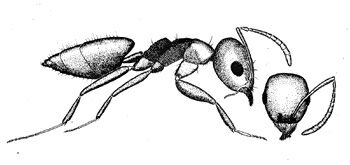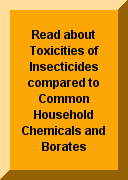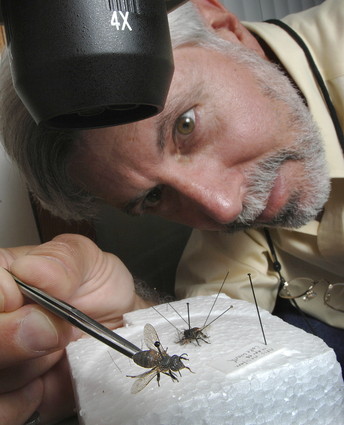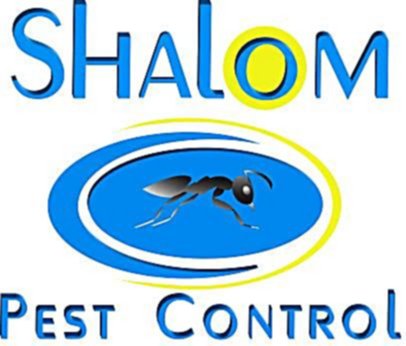Dr. John Warner, Owner, Certified-Operator
Ph.D. Entomology, University of Florida
Entomology Links
Technomyrmex albipes
561-477-8664
My Publications and Press Releases
This page was last updated on: January 17, 2023
Article about my work which I can not link to:
Sun-Herald article 5/24/2002
12 August 2002 these 3 items:
Sun-Sentinel, page one: "UF inventors come up with better defense against white-footed ants"
National Public Radio station - John Warner interviewed by David Blackwell, WXEL Sun-Sentinel News: click to listen:
CBS and Fox News interview of John Warner filmed 12 August 2002 at the University of Florida Ft. Lauderdale Research and Education Center
...by the way.. "NecDew" refers to "nectar" (produced by plants) and "honeydew" (produced by sap-sucking insects, such as aphids and scales). NecDew is a nectar and honeydew mimic. Ants LOVE this stuff!!
(NecDew is a "bait matrix". There is nothing toxic in NecDew. Various toxicants can be added to make it toxic to ants.)
PAGE 2
In 2002, articles about NecDew appeared in 2 magazines and several newspapers around Florida, for example:
"Featured Creature" article. This ant has been causing lots of problems on Florida's East Coast, especially around
West Palm Beach... (sometimes called a "brown crazy ant").
!!!!! August 2006: I found an infestation in Boca Raton!!!!!
Paratrechina pubens
Camponotus floridanus and C. tortuganus
Camponotus planatus
...saving the best for last...
Non-technical with PHOTOS OF WHITE-FOOTED ANTS
(Numerous other newspapers and magazines carried this story)
I went on my second Baha'i Pilgrimage 2-10 February, 2004. This is one out of over 600 photos that I took.
Click (above) on "The Baha'i Faith" or the new international website "Baha'u'llah" to learn what this is all about...
Mt. Carmel, Haifa, Israel
White-Footed Ant
"Featured Creature" article---------------------------->
NecDew is a University of Florida technology that is available for licensing. For information:
Question for "scientists"
Could a true scientist go through life and miss the most significant event in human history even though the signs are right in front of him?
For Myrmecologists:
An excellent novel by
F.P. Grove (1947) Consider Her Ways
click:
For homeowners:
Florida Wax Scale (Ceroplastes sp.) killing Eugenia plants. This is a problem that I have seen at many homes in Broward and Palm Beach Counties. The scales produce a lot of honeydew that ants feed on. Sooty mold also grows on this honeydew (black material on the leaves in the photo). My suggestion is to plant resistant ornamental varieties.
FEEDING PREFERENCES OF WHITE-FOOTED ANTS, TECHNOMYRMEX ALBIPES (HYMENOPTERA: FORMICIDAE), TO SELECTED LIQUIDS
(published in Sociobiology August 2004) -------------------------->
NecDew articles etc.:
photo
send email:
Laboratory Evaluation of Baits, Residual Insecticides, and an Ultrasonic Device For Control of White-Footed Ants, Technomyrmex albipes (Hymenoptera: Formicidae)
Work is suspended on Baha'i Holy Days:
Thesis has background info on white-footed ants and experimental work
Dr. John Warner speaking about NecDew at the National Conference on Urban Entomology, Raleigh, NC. 25 May 2006
Killer Bees
Have touble falling asleep? Have you tried counting ants? Click HERE for ants to count.
Two "Featured Creature" articles on carpenter ants.
.
and July 2007 in Parkland!
Name correction! This ant is Technomyrmex difficilis (click here)
Barry Bolton has determined the ant that we have here in Florida which we have been calling “white-footed ant” (Technomyrmex albipes), is really Technomyrmex difficilis (Bolton 2007). In Bolton’s description of difficilis he states: “Closely related to albipes but separated by the presence of setae [erect hairs] on the dorsum of the head behind the posterior margin of the eye (never developed in albipes) and by having the promesonotum somewhat longer and more slender… This species has been confused many times with albipes…”
James Wetterer at FAU is preparing an article regarding this name correction and plans to propose a common name for T. difficilis. I am not in favor of a different common name. I think that the common name for T. difficilis should be “white-footed ant” because that is how it is known in numerous publications and by the public in this country and a new common name will cause unnecessary confusion.
Reference
Bolton, B. 2007. Taxonomy of the dolichoderine ant genus Technomyrmex Mayr (Hymenoptera: Formicidae) based on the worker cast. Contributions of the American Entomological Institute 35, 1-150.
Warner, John, Rou-Ling Yang and Rudolf H. Scheffrahn --Efficacy of Selected Bait and Residual Toxicants for Control of Bigheaded Ants, Pheidole megacephala (Hymenoptera: Formicidae), in Large Field Plots ...FLORIDA ENTOMOLOGIST V.91 #2, 277-282 CLICK HERE FOR PDF
raspberry ant, raspberry ant
33437
33436
33426
33435
33446
33484
33445
33444
33483
33496
33486
33498
33434
33431
33428
33433
33486
33432
33067
33073
33442
33441
33064
33063
33066
33069
33060
33062













